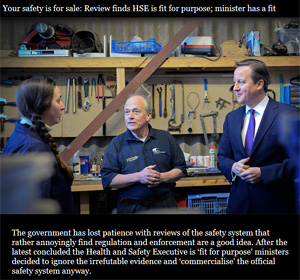In a special report published last month (March) on the Hazards Magazine website, edito Rory O'Niell discusses the current situation over government reviews of the HSE:
When ministers hand-picked Martin Temple to head up the Triennial Review of the Health and Safety Executive (HSE) they had high hopes he’d brand the watchdog a burden-mongering, innovation-stifling monster to be summarily slayed.
Temple is chair of the manufacturing industry lobby group EEF and its former director general. EEF’s February 2013 report, Making health and safety work for business: Removing unnecessary health and safety burdens, seemed to speak minister speak. The accompanying EEF news release noted “the cost in terms of time and money of complying with health and safety regulation is increasing and manufacturers’ views of its benefits and of their relationship with regulators has become substantially less positive.”
 The review was a big deal. If Temple didn’t like what he saw, it could mean the end of HSE, under the government’s December 2010 Reducing regulation made simple plan to “sunset” regulations and regulators that were no longer deemed necessary or whose functions could be hived off elsewhere.
The review was a big deal. If Temple didn’t like what he saw, it could mean the end of HSE, under the government’s December 2010 Reducing regulation made simple plan to “sunset” regulations and regulators that were no longer deemed necessary or whose functions could be hived off elsewhere.
Martin Temple though, did like what he saw. His report published three months late on 9 January 2014 emphasised the important role HSE plays in reducing injury and ill-health caused by work, concluding it was “fit for purpose.” Temple declared “unequivocal” support for HSE, stressed the importance of its regulatory role and called for a renewed push to prevent occupational diseases.
His report noted: “In both development of standards and submitting proposals for legislation, HSE’s strength was seen to be its technical expertise and its access and contact with all the relevant stakeholders (employers and employee representatives).”
The report also opposed the government driven “dumbing down” of guidance. “Simplicity is welcomed, dumbing down is not,” it said.
It was also critical of the fee for intervention (FFI) scheme, used by HSE to help plug a gaping funding chasm, “creating the impression that HSE has an income target to achieve.” This has made firms suspicious of HSE’s motives and more reluctant to seek its advice. The report added that FFI had “damaged HSE’s reputation for acting impartially and independently, and thereby its integrity as a regulator.”
Far from wanting more reform to get HSE off their backs, Temple found firms wanted to see more of HSE. They were unhappy with David Cameron’s decision to axe what the prime minister characterises as “needless” unannounced inspections.
Temple’s report notes: “A consequence of the reduction in HSE proactive inspections is that HSE is not spending as much time engaging with those organisations with a mature health and safety management system. They are concerned that they do not get enough HSE time/support in stimulating and assisting them deliver continuous improvement in their performance and that of their supply chain – which they see as integral to their business philosophy and sustainability.”
But most galling of all for ministers was the report’s outright rejection of the privatisation of HSE functions, noting an HSE which is a “non-departmental public body remains the appropriate delivery model.”
The Triennial Review uncovered a smörgåsbord of pro-HSE sentiments that safety minister Mike Penning found entirely unpalatable. Insiders say on seeing the draft report, the apoplectic minister put pressure on Temple to change his conclusions to justify stripping HSE of some or all of its role, delaying the publication for months while the arm-twisting continued.
Temple, though, stood firm. And when the publication finally emerged, Penning was ready with his response.
His 9 January 2014 ministerial statement said the government wants “to go further to introduce reforms of HSE to ensure that it delivers value for money to the taxpayer, whilst ensuring safety for the nation.
 “There is considerable potential for HSE to become more commercial in outlook and in delivery – increasing the pace of the work already started within the organisation. Therefore, I have asked HSE to begin work immediately to examine commercial models for HSE in collaboration with HMT [the Treasury] and Cabinet office, and to review the HSE Board to ensure it has the right skills to oversee future efficiencies and commercial income generating options.”
“There is considerable potential for HSE to become more commercial in outlook and in delivery – increasing the pace of the work already started within the organisation. Therefore, I have asked HSE to begin work immediately to examine commercial models for HSE in collaboration with HMT [the Treasury] and Cabinet office, and to review the HSE Board to ensure it has the right skills to oversee future efficiencies and commercial income generating options.”
The Triennial Review is the latest in a resource-sapping series to examine the health and safety system, following the Young and Löfstedt reports and the ‘Red tape’ challenge.
TUC general secretary Frances O’Grady said:
“There was huge support from all those who responded to the review for the work of the HSE as a public body. We believe that, given the scale of injury and illness across UK workplaces, the government should not undermine the ability of the HSE to meet that challenge.”
 TUC head of safety Hugh Robertson said HSE had been “reviewed to death”, adding:
TUC head of safety Hugh Robertson said HSE had been “reviewed to death”, adding:
“So once again they have asked a question and because they do not like the answer they are going to go ahead with what they clearly wanted to do anyway.”
He said the last minute government decision to scrap the recruitment process for a new HSE chief executive after final interviews had taken place – with acting chief Kevin Myers one of those snubbed - suggested the government now intended to “appoint someone who will share their zeal for greater commercialisation.”
The government all along wanted a regulator neutered or reformed to the point of irrelevance. It’s just the evidence stubbornly refused to support this.
The pretence has now finished, and the fear is HSE could be too.
Source: Hazards Magazine
Join Hazards and get their magazine delivered direct to your home: here



 “There is considerable potential for HSE to become more commercial in outlook and in delivery – increasing the pace of the work already started within the organisation. Therefore, I have asked HSE to begin work immediately to examine commercial models for HSE in collaboration with HMT [the Treasury] and Cabinet office, and to review the HSE Board to ensure it has the right skills to oversee future efficiencies and commercial income generating options.”
“There is considerable potential for HSE to become more commercial in outlook and in delivery – increasing the pace of the work already started within the organisation. Therefore, I have asked HSE to begin work immediately to examine commercial models for HSE in collaboration with HMT [the Treasury] and Cabinet office, and to review the HSE Board to ensure it has the right skills to oversee future efficiencies and commercial income generating options.”  TUC head of safety Hugh Robertson said HSE had been “reviewed to death”, adding:
TUC head of safety Hugh Robertson said HSE had been “reviewed to death”, adding: